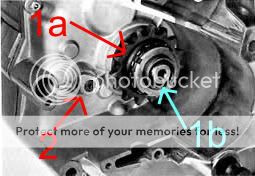Just to add a little to what others have said (and please correct me, guys, when I've erred anywhere or missed something out).
P.s The answer to 'What torque ...?' is in point 5 below

. But read on ...
There are 2 possible sources of a leak in this area:
1. The seals on the gearbox drive shaft.
2. The seal behind the neutral indicator switch.

The most frequent culprit is the larger of the seals behind the drive sprocket - marked 1a in the picture above. So I’ll deal with that for now.
To remedy it, you need to remove the old one and replace it. Its size is 45x60x10 and it's part no. is 0647.49.325.
Note: This seal and the tools mentioned below should all be available from your preferred Ducati specialist supplier.
Take the cover off, and prise back the tab(s) of the lock washer. Now you need to use the correct tools to remove the sprocket: first, the one to turn the sprocket nut ...

The second to hold the sprocket still.

You can devise a method of locking up the sprocket that does not require the use of this second special tool. But I don’t advise this approach -see point 5 below for one reason why; so I’m not going to tell you how

!
Note: When you buy one of these tools, try to get one that can be used with
both 15 and 16 tooth sprockets. Now, it's possible that that is all that is available these days, anyway; but, believe it or not, the original Ducati tool was either for 15 tooth .. or for 16. So you could finding yourself needing both ...

.
Once the sprocket is off, it’s the turn of the seal. To remove this, you need to carefully drill two small holes
right thru the seal. Into these holes you screw two appropriately sized self-tapping screws. Leave enuf of these screws projecting so that you can grab hold of them with some mole-grip pliers, one set of pliers on each screw. And pull. The seal will come out. It may take some pulling and pleading, but it will come …
You then install the new seal. (Personally, I lube the seal with a light trace of grease to ease insertion). Make sure it is fitted flush. Further re-assembly is the reverse of the disassembly. Again, you need to use the two special tools. Some other points:
1. The sprocket goes back with the wider boss facing OUT.
2. The lock nut goes back with the chamfered face up against the tab washer. And you should consider changing the tab washer for a new one.
3. As stated above, you can consider using a little silicone or Loctite on the lock nut. The silicone trick was one that was told to me by a certain Steve Wynn (who also recommended using two of the lock nuts - your choice).
4. There is also available a lock nut with a nylon inner seal. I got one some time ago, can't I remember from where now; but I have a note that the SKF reference is GUK7.
5. The torque loading on the nut should be 70-84 ft/lb (100-120 Nm). That, in plain English, is tight … and then some. And THAT alone is a very good reason why you should use the proper tool for locking up the sprocket

.
HTH
Craig



